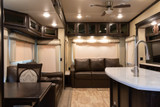How to Care for your RV Awning
The awning on your camper or RV can be your best friend on a super sunny day or a wet and rainy one. It’s important that this shade structure get a little tender loving care from time to time to keep it operational when you need it.
There’s something welcoming about putting up the awning, setting the chairs out and relaxing under cover with a cool drink or maybe a sweet treat. It also is your welcome mat, the front steps to your campsite and a beacon to friendly campground neighbors. Who knew that this practical camper accessory was so important, too?
There are two kinds of awnings, manual and electric. While there are differences in how each one operates, both benefit from routine maintenance and cleaning. Whether the awning itself is acrylic or vinyl, periodic cleaning and inspection makes a difference. If repairs are needed, kits are available to fix any small rips, tears or holes.
Here are the ways to keep your awning functioning well
- One of the first tasks you can do to give the awning a little attention is to wash it. Whether your awning is made from acrylic or vinyl, a hosing off may be all it needs to remove the leaves, sticks and other crud that has fallen onto it.
- Most of the time, an awning does not need anything more than a little rinsing from a hose. There may be times when more is needed to clean a stain or particularly dirty patch. A cleaning product that is suitable for vinyl or acrylic is your best choice to avoid causing any damage to the material.
- Bleach should only be used when mold is present or for really tough-to-remove stains. The chlorine in bleach can degrade the material over time so it should be used sparingly.
- A soft brush can be used to tackle those spots but be gentle to avoid wearing down the waterproofing applied to the awning. Acrylic awnings can stand up to a little more elbow grease so a stiffer brush works well on these awning types. Consider a brush with a longer handle to clean those spots out of arm’s reach.
- Make sure to rinse well and dry thoroughly before rolling the awning away.
- Be wary of the elements when your awning is in place. If it is raining, prevent water from pooling on the awning. The extra weight of the water could cause structural problems for the awnings’ supports. Simply making sure one corner of the awning is lower than the others will keep the water flowing off the awning.
- If this plan is in place, location of the lowered corner is important. Direct the rain water away from the camper and away from people. Getting hit with a puddle of rainwater is not always a pleasant experience.
- Along that same line, take steps to limit the sunlight that hits your awning. When you are not in camp, put the awning away and roll it out when you return. The ultra-violet rays of the sun can degrade the weatherproofing and destroy the material the awning is made from.
- Protect your awning from the ravages of wind with clamps that are engineered to reduce the flapping noises and stabilize your awning against rips and tears. When placed in the center of the awning, it redirects the force of the wind away from the ends, preventing damage. Better yet, when you are expecting strong winds, roll up your awning and secure it in place.
- When looking over your awning for mold, mildew, tears or other damage, or when you are getting ready for the season, also look at the mechanisms that make the awning work. If the supports are bent, dented or damaged, the awning may not work properly.
- Make sure the moving parts that allow your awning to pull out and retract are properly lubricated. If you hear any squeaking coming from the awning apparatus, it most likely needs to be lubricated. Silicone spray is a good choice for making sure the parts move together smoothly. Be careful not to over lubricate. Too much lubrication can cause dust and dirt to collect on the mechanisms.
- Look over all hardware that is part of the awning system. Watch for damaged brackets and missing screws that secure the awning to the mechanisms. If the hardware is rusted or damaged, replace it. Inspect the roller tubes and arm pivots to make sure these are working correctly. Pivots do require lubrication for smoother operation.
Common sense tells us to make sure the awning is secure when hitting the road. Having a lock to secure the awning in place is added security. Check your system to make sure the awning will stay rolled up when it needs to be.
By adding awning inspection to your to-do list before taking the RV out for the season, problems can be identified early. Don’t ignore a small hole or moldy spot because that could lead to bigger and more costly problems.
Recent Posts
-
Can You Put Regular Furniture in an RV?
Many new and old RV owners ask themselves this question when they feel the need to update th …Apr 25th 2024 -
4 Tips for Securing RV Furniture While Traveling | RecPro
How To Secure RV Furniture There are few things that beat going out on an adventure with an RV …Apr 25th 2024 -
How To Keep RV Furniture From Peeling
Peeling RV Furniture | Why it Peels and How to Stop it Your RV furniture is a point of pride on yo …Apr 25th 2024 -
Turning up the Heat With an RV Fireplace
There’s an unlimited number of cool and exciting features you could add to your recreational vehicle …Apr 25th 2024 -
How To Install An RV Fireplace
A Warm Addition to Your On-Wheels: The DIY RV Fireplace Installation Guide Many RV enthusiasts ask …Apr 25th 2024 -
Are RV Electric Fireplaces Safe
Being Safe in Your RV with an Electric Fireplace Safety is always going to be one of your highest …Apr 25th 2024







